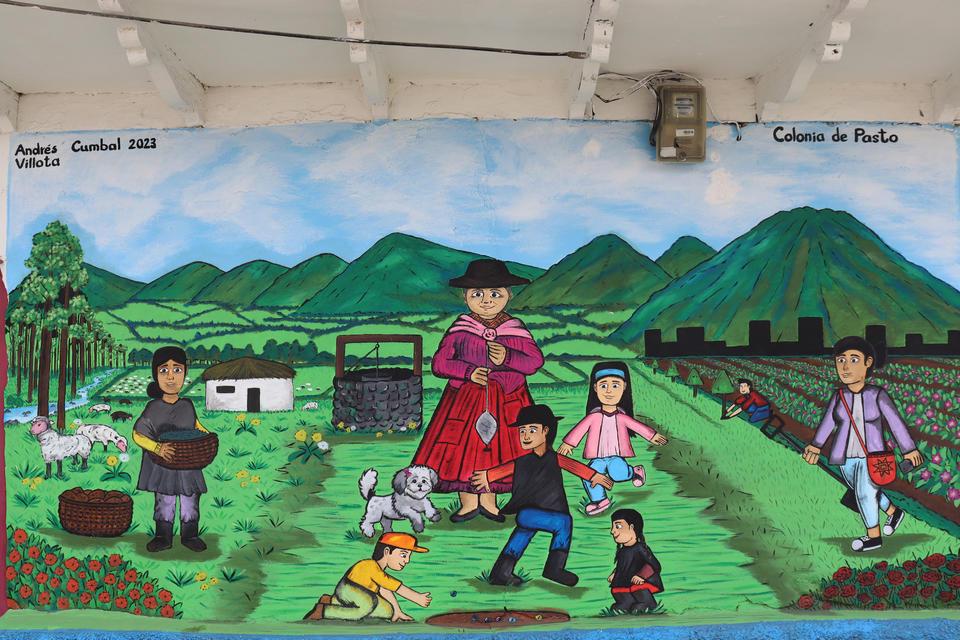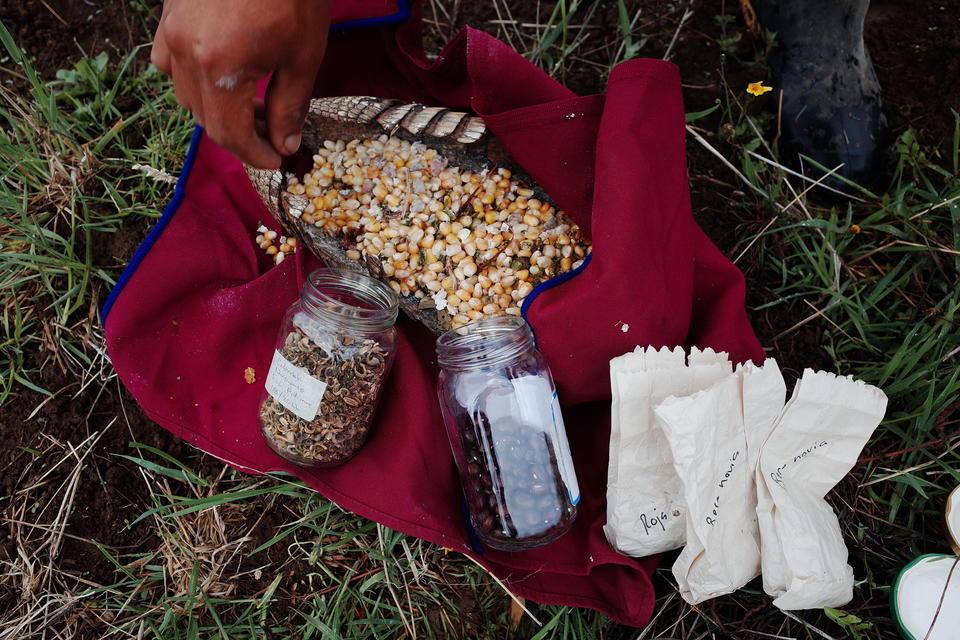Research Articles Women are Key Custodians of Biodiversity, and COP16 Could Strengthen their Conservation Efforts

The participation, voice and leadership of women in conserving biodiversity is critical to reversing the biodiversity crisis. But grassroots women are typically excluded from the decision-making, capacity-building, and finance designed to conserve biodiversity. Participants at the Biodiversity Conference this year have the tools to change the status quo.
Grassroots women worldwide are exemplary custodians of biodiversity. Moreover, they are organizing and taking action for biodiversity’s sustainable use, management, conservation, and restoration. Governments and a range of other stakeholders, in alignment with the Convention on Biological Diversity (CBD), demonstrate growing support for these efforts. But power inequalities still prevent women from being meaningfully represented in the decision-making processes that define their rights, responsibilities, and access to the benefits of biodiversity, which should be equitably shared for all.
Gender and inclusion issues tied to biodiversity should remain a top priority for countries at the 16th session of CBD’s Conference of the Parties (COP16) in Cali, Colombia. In a new policy brief we partner with experts from several international organizations to outline the challenges facing the gender-responsive implementation of the Kunming-Montreal Global Biodiversity Framework (KM-GBF) adopted in 2022. We propose a series of concrete solutions, with clear examples of success stories, that Parties to the Convention (almost 200 countries and territories) can use to ensure that their efforts to conserve and sustainably use biodiversity are gender-responsive.
Supporting gender equality helps all people. And the planet.
Decisive action is required to halt and reverse biodiversity’s global decline, which converges with the crises of climate change, nutrition and food insecurity. World leaders are grappling with difficult decisions required to address these existential threats. The inclusion of women in all their diversity, particularly from Indigenous Peoples (IP) and local communities (LCs), who are on the frontlines of conserving and sustainably using biodiversity, has shown, time and again, to be effective in efforts to make meaningful changes across the globe’s spectrum of challenges.
Supporting women in these efforts requires funding and institutional support. It is encouraging, then, that at COP15 in Montreal in 2022, Parties to the Convention adopted a Gender Plan of Action (2022-2030) that provides clear and thorough guidance for achieving goals tied to gender equality and biodiversity. The plan has clear expected outcomes, objectives, and indicative actions. It delineates timelines and responsibilities.
The Gender Plan of Action builds on a previous similar plan. Helpfully, a review of the prior effort identified several challenges that need to be overcome to mainstream concerns for gender equality in the Convention. These include gaps in capacity development; collection and analysis of sex-disaggregated data and reporting; and finance.
Despite progress, issues related to gender equality and inclusion are often treated as an add-on – as opposed to an integral part – of National Biodiversity Strategies and Action Plans. This leads to inefficiencies, including in how limited biodiversity resources are used, and generates missed opportunities. Greater coordination of efforts among the many sectors of government involved in biodiversity conservation, and among government and civil society, NGOs, research organizations, the private sector, and other concerned actors – locally, nationally and regionally – could help fix this.
Sustained engagement, voice
The full and effective participation and leadership of grassroots women – in particular, women from IP and LCs and other people facing multiple forms of discrimination – in biodiversity-related processes central to their livelihoods is a human right. Women’s full and effective participation and influence are also critical to implementing the KM-GBF in countries and achieving the targets on both gender equality and biodiversity because grassroots women have deep understanding of local ecosystems, cultural practices, and social dynamics. Ensuring their participation in biodiversity-related decision-making is key to aligning national policies with local realities.
Right skills, people, places
Countries, even with the best intentions to integrate gender considerations into environmental plans, often lack the practical ability to achieve results. Most countries struggle to bring gender equality into their biodiversity actions, partly due to a lack of expertise and resources to develop these capacities. Changing this will require focused efforts on awareness-raising and capacity-building for policymakers, practitioners, and women’s groups to enable them to contribute fully and effectively to CBD processes.
The Gender Plan of Action outlines actions to boost the involvement of women and girls and enhance the capacity of governments and other stakeholders to address gender equality through biodiversity policy and programs. Collaboration and the full and meaningful involvement of women’s organizations as well as providing them with the needed resources will help enable them to lead sustainable biodiversity actions in their communities. Similarly, the governments that support them need to strengthen their capacity to understand how to provide appropriate support and to use their authority to work across political or jurisdictional barriers.
A first step is to strengthen the capacities of gender-biodiversity focal points, the CBD country representatives tasked (in some countries) with supporting knowledge exchange, sharing of experiences and best practices, peer-to-peer learning, mentoring and coaching on gender equality issues. Capacity building should be tailored to specific needs, and should involve hands-on learning for both women and men. These efforts should be aligned with broader initiatives to strengthen capacities related to biodiversity.
Data gaps: Embrace collaboration and local knowledge
More gender-responsive data collection, analysis and application of findings is critical for more successful biodiversity action. The Gender Plan of Action underscores the need to collect data disaggregated by sex and other relevant social characteristics, like age and ethnicity, and to develop capacities to produce and apply this data.
Costa Rica’s data-driven approach to developing gender-responsive biodiversity policies
Costa Rica is conducting gender analyses and gap assessments in the environmental sector to inform the development of a Gender Action Plan as part of its carbon-capture through forests (REDD+) strategy. Using sex-disaggregated data from a 2014 census, the analysis revealed that only 15.6% of farm owners were women and that they had limited access to land, technical assistance, and financing. This data-driven approach led to gender-responsive changes in policies, governance, and finance, to ensure women and men benefit equally from biodiversity and restoration efforts.
To generate efficiencies, data collection to guide gender-responsive biodiversity action should be coordinated across relevant multilateral environmental agreements (such as the three Rio Conventions on climate, biodiversity and desertification). This will help increase the amount of data needed to guide more targeted gender-responsive biodiversity action. Data collection should embrace and involve IP and LCs and women’s organizations, incorporating their diverse knowledge systems. These efforts are needed to track and understand progress – or shortcomings – of implementation efforts against gender equality and biodiversity conservation commitments.
More finance, top-level collaboration
More international and national finance, public and private, is crucial for the gender-responsive implementation of global environmental agreements. Importantly, however, for efficient use of these resources, investments must be integrated, coherent, comprehensive and coordinated across environmental conventions, policies and gender action plans, such as those adopted under the three Rio Conventions, which include the CBD.
Financing for gender equality and biodiversity is often separated but there are growing efforts, such as through feminist foreign policies and gender-responsive budgeting, to combine these finance streams. Governments are key to ensuring efficient resource allocation and utilization by coordinating and aligning environmental programming with gender equality objectives.
Crucially, women’s organizations and women-led initiatives need unrestricted, timely and predictable funding for their biodiversity initiatives. Supporting women, particularly from IP and LCs, to secure financial resources, assets, credit and other financial services has the potential to transform biodiversity and sustainability efforts.
There need to be significant adjustments to the usual approach to addressing gender equality and biodiversity. We hope the brief will help guide countries so that by 2030, when the current Gender Plan of Action concludes, we see tangible and long-lasting results demonstrating that gender equality has advanced through biodiversity conservation action.
Written by Marlène Elias, Director of Gender and Inclusion, and Miranda Morgan, Gender Scientist, of the Alliance of Bioversity International & CIAT, based on a brief co-authored with Katherine Despot-Belmonte (UNEP-WCMC), Verona Ancheta Collantes-Lebale (Global Environment Facility), Amelia Arreguin Prado (CBD Women’s Caucus), Dominique Blaquier, Juan Casado-Asensio and Cibele Cesca (OECD), Ciara Daniels (UNDP), Maren Kraushaar (GIZ/NBSAP Accelerator Partnership) and Tanya McGregor (UNEP). Additional writing and editing for this piece by Sean Mattson and José Luis Urrea.
Our position paper "Placing Gender Equality at the heart of the implementation of the Global Biodiversity Framework" identifies the challenges and opportunities for pursuing the range of actions to promote the gender-responsive implementation of the KM-GBF and provides recommendations for implementation.
The Team

Marlène Elias
Director, Gender and Inclusion



